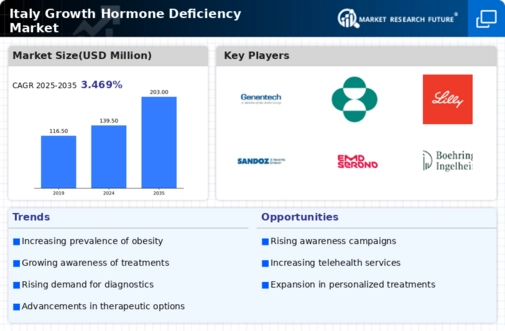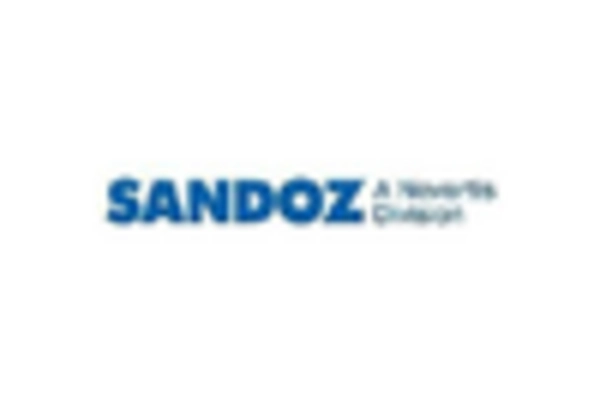Enhanced Diagnostic Techniques
Advancements in diagnostic techniques are significantly influencing the growth hormone-deficiency market in Italy. The introduction of more precise and less invasive testing methods, such as MRI scans and blood tests, has improved the accuracy of diagnoses. This is crucial, as early detection can lead to more effective treatment outcomes. The market is likely to benefit from these innovations, as healthcare professionals are better equipped to identify growth hormone deficiencies. Moreover, the Italian healthcare system's focus on improving diagnostic capabilities may lead to an increase in the number of diagnosed cases, further propelling the growth hormone-deficiency market. As a result, patients are more likely to receive timely interventions, which can enhance their quality of life.
Increased Focus on Personalized Medicine
The growth hormone-deficiency market in Italy is witnessing a shift towards personalized medicine, which tailors treatment plans to individual patient needs. This approach is becoming increasingly relevant as healthcare providers recognize that growth hormone therapy is not a one-size-fits-all solution. Factors such as age, weight, and specific health conditions can influence treatment efficacy. Consequently, pharmaceutical companies are investing in research to develop customized therapies that cater to diverse patient profiles. This trend may enhance patient outcomes and satisfaction, thereby driving market growth. As personalized medicine continues to gain traction, the growth hormone-deficiency market is likely to evolve, offering more targeted and effective treatment options for patients.
Growing Investment in Pediatric Healthcare
Investment in pediatric healthcare is a significant driver for the growth hormone-deficiency market in Italy. The Italian government and private sectors are increasingly allocating funds to improve healthcare services for children, which includes addressing growth disorders. This trend is reflected in the rising number of specialized clinics and healthcare facilities dedicated to pediatric endocrinology. As a result, more children are likely to receive appropriate evaluations and treatments for growth hormone deficiency. The market could see substantial growth as these investments translate into better access to care and innovative treatment options. Additionally, the emphasis on pediatric health aligns with broader public health goals, potentially increasing awareness and diagnosis rates in the population.
Rising Prevalence of Growth Hormone Deficiency
The growth hormone-deficiency market in Italy is experiencing an increase in prevalence rates, particularly among children and adolescents. Recent studies indicate that approximately 1 in 4,000 children may be affected by this condition, leading to a growing demand for diagnostic and therapeutic solutions. This rise in prevalence is likely to drive market growth as healthcare providers and families seek effective treatments. Furthermore, the increasing recognition of the long-term impacts of untreated growth hormone deficiency, such as impaired growth and metabolic issues, underscores the necessity for timely intervention. As awareness continues to spread, the growth hormone-deficiency market is expected to expand, with more patients seeking medical advice and treatment options.
Rising Awareness Among Healthcare Professionals
There is a growing awareness among healthcare professionals regarding the implications of growth hormone deficiency, which is positively impacting the growth hormone-deficiency market in Italy. Continuous medical education and training programs are being implemented to equip doctors with the knowledge necessary to identify and manage this condition effectively. As healthcare providers become more informed about the symptoms and long-term consequences of untreated growth hormone deficiency, they are more likely to screen patients and recommend appropriate treatments. This increased awareness could lead to a higher diagnosis rate, subsequently expanding the market. Furthermore, collaboration between endocrinologists and general practitioners is likely to enhance patient referrals, further driving growth in the growth hormone-deficiency market.

















Leave a Comment